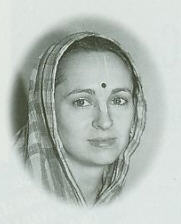
Urmila Devi Dasi
I'M WATCHING ROHINI, a thirteen-year-old with definite artistic talent and promise. She boards at our home to attend school here, and she spends every spare moment with her art pad and pencil. As she fills each page, the lines magically fuse and bend to reveal the Lord, His pastimes, and His associates.
Rohini's drawings unlock the memory of my own first drawings of Krsna. Perhaps because my older sister attended Cooper Union School of Art in New York City, I was naturally drawn to art oil, pencil, charcoal, pastel. After two years of art in high school, I went on to study drawing and sculpture in college. But I became disgusted with meaningless swirls of color and pattern, or twisted bits of metal and wood. Through art, I wanted to communicate truth, beauty, and purpose.
Then I met devotees of Krsna. What a pleasure to learn from Srila Prabhupada that I could meditate on Lord Krsna, the Absolute Truth, who is full of unlimited beauty and meaning! My mind and senses, for so long my enemies, could now act as friends by thinking of and portraying the Lord.
Full of excitement, I started my first Krsna conscious drawing Krsna dancing with the gopis, the milkmaids of Vrndavana. I can't say I understood anything of the Lord's pastimes, His opulence, or even my own spiritual identity. But from Prabhupada's teachings I knew that Krsna could appear in my picture if I worked with devotion.
With whatever tiny spark of devotion I could coax out of my heart, I started to move the pencil, just as I had done in countless art classes. But this session was different. I no longer felt I was the creator. I thought of Jambavan's prayer to Lord Krsna in Prabhupada's book Krsna: "Not only are You the creator of the creators, but You are also the creator of the material elements the so-called creators manipulate."
I understood that I was simply manipulating the paper, my hand, the graphite and wood of the pencil. Krsna had created all these, and they were under His control.
Did I have the power to depict the Supreme Lord of creation with my puny pencil? No, but by Krsna's grace He manifested Himself on my paper, despite my lack of artistic skill and my glaring spiritual shortcomings. I felt overwhelmed by His kindness.
"Being pleased by our devotion," I tell Rohini, "Krsna comes onto our paper. We show our devotion simply by trying to draw Him."
She leans back, examining her work with a critical eye, deciding to change the pleats of Yasoda's sari.
Worshiping Krsna through art is perhaps one of the most natural, simple, and pleasing kinds of yoga, even for the youngest child. When I was barely a beginner among beginners in Krsna consciousness, I could perceive the Lord's transcendent reciprocation through art. And similarly, through art, even a child without philosophy, austerity, or renunciation can begin to love the Lord.
Perhaps one of the sweetest aspects of devotional art is that it's a way most children naturally want to serve Krsna. The greatest hurdle in any educational subject, that of getting the student to want to learn, is already overcome. The only task for the parent or teacher is to direct and structure the child's inner desire.
Once a child is two years old or so, he or she can learn to color a picture within the lines, using suitable colors. When children of any age create their own pictures, they should stick to portraying Krsna and His pastimes as the scriptures describe.
Children must learn respect and veneration for drawings of Krsna, because without these attitudes the children's devotion cannot blossom. The children learn that drawings should not be put on the floor, touched by the feet, or brought into a toilet room.
Children can start learning some artistic techniques as soon as the children are ready for school. Brush strokes, color theory, simple perspective, balance of designs all are useful for any child, whether or not he or she becomes an "artist." Without such instruction, the older child or adolescent may feel hesitant, not wanting to keep turning out "flat" or "stick" drawings, and lose interest in art. But a child who receives the basic instructions will easily keep alive the spontaneous creative urge.
Resources For Teaching Drawing Skills
For children age four or five through adult:
Drawing with Children, by Mona Brookes. Published by Jeremy P. Tarcher, Inc., Los Angeles. Distributed by St. Martin's Press.
Drawing Textbook, by Bruce McIntyre. Published by Audio-Visual Drawing Program, 1014 North Wright St., Santa Ana, CA 92701.
For students age twelve and older or those who have developed basic drawing skills, here is a good source of books for beginning art, advanced art, and brush art: Basic Education, P. O. Box 1438, Lewisville, TX 75067-1438. Phone: 1-800-925-7777, or (214) 315-1776. (They have many international branches as well.)
Urmila Devi Dasi was initiated in 1973 and has been involved in ISKCON education since 1983. She, her husband, and their three children live at the ISKCON community in Hillsborough, North Carolina, where she runs a school for children aged 5-18. She is the main author/compiler of Vaikuntha Children, a gurukula classroom guidebook.
